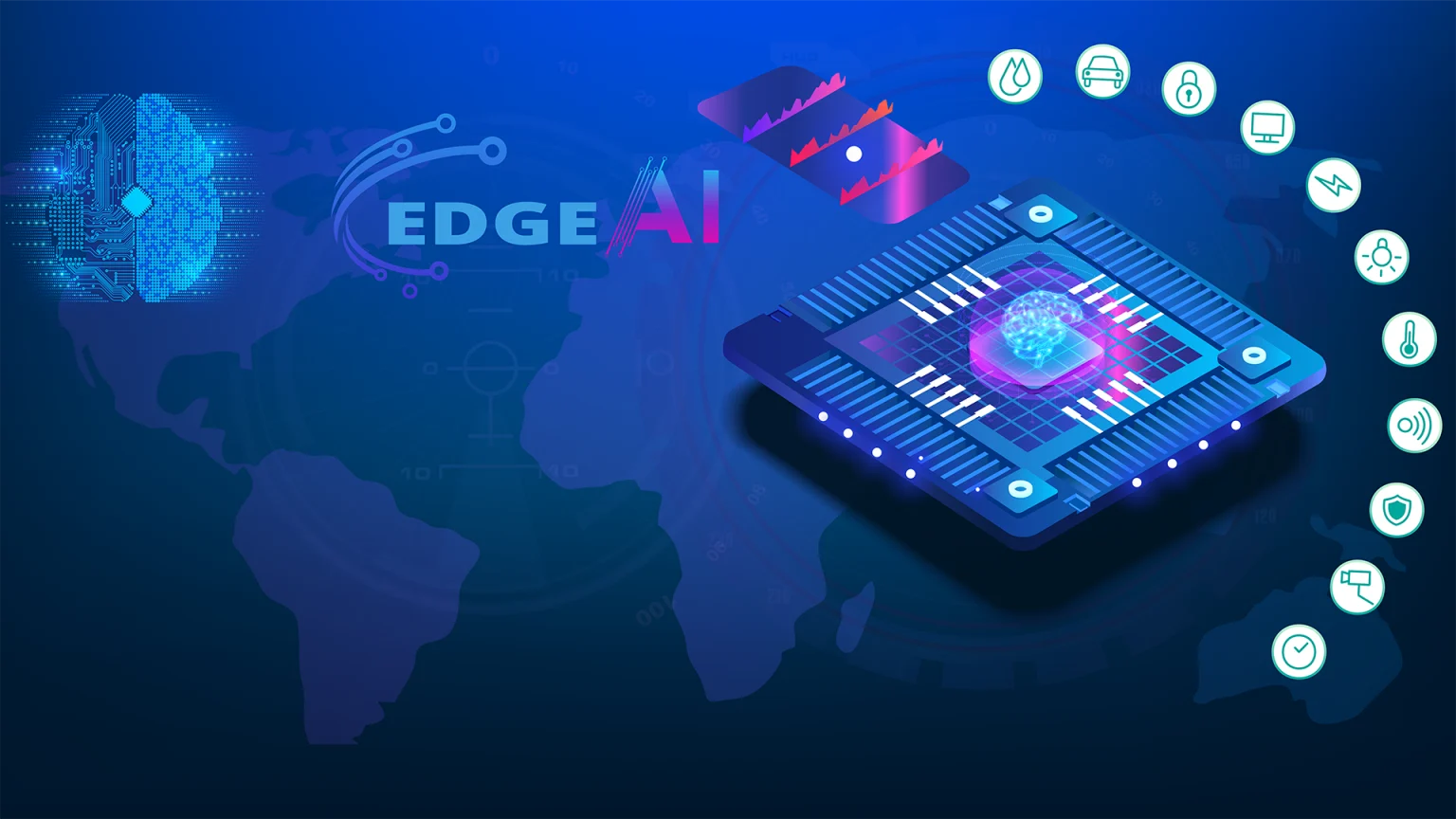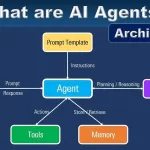What is Edge AI? Navigating Artificial Intelligence at the Edge
AI Edge: Artificial Intelligence at the Edge: Artificial intelligence (AI) at the edge , known as Edge AI , is transforming the way businesses manage and process data. Unlike traditional AI models that rely on the cloud for processing, Edge AI brings intelligence directly to the devices and systems where the data is generated. In this article, we’ll explore what Edge AI is, its benefits, use cases, and how it’s revolutionizing various industries.
What is AI Edge?
Edge AI refers to the implementation of artificial intelligence and machine learning algorithms directly on local devices , such as sensors, cameras, smartphones, and other connected equipment. This allows data processing and analysis to be performed locally, rather than relying on remote servers or the cloud.
Its key components
Edge devices: These include any hardware capable of running AI algorithms , such as smart cameras, IoT devices, smartphones, and gateways.
AI Algorithms: Machine learning and data processing models that can be deployed and executed locally.
Connectivity: Networks that enable communication between edge devices and central systems , facilitating data transfer when necessary.
Development platforms: Tools and frameworks that support the development and deployment of AI Edge applications, such as TensorFlow Lite , Edge Impulse , and AWS IoT Greengrass .
Benefits of Edge AI
Reduced latency: Edge data processing significantly reduces latency , as data doesn’t need to travel across the network to a central server. This is crucial for real-time applications such as autonomous vehicles and rapid response systems.
Improved security and privacy : By keeping data local, the risk of vulnerabilities during transmission is reduced. This is especially important in applications that handle sensitive or confidential information.
Bandwidth efficiency: Local data processing minimizes the need to send large volumes of data to the cloud , optimizing bandwidth usage and reducing data transfer costs.
Operational resilience: Systems can continue to operate even when cloud connectivity is limited or intermittent , ensuring greater operational continuity.
Use cases
Autonomous Vehicles: Autonomous vehicles use Edge AI to process sensor and camera data in real time , making instant decisions necessary for navigation and safety.
Smart Security Cameras: Security cameras equipped with AI Edge can detect suspicious activity and send instant alerts , improving security and surveillance efficiency.
Smart manufacturing: In the manufacturing industry, it is used to monitor equipment and processes in real time , detecting faults and optimizing preventive maintenance.
Healthcare and Medicine: Medical devices equipped with AI Edge can monitor vital signs and perform preliminary diagnoses, offering fast and accurate responses in critical situations.
Challenges and future of AI Edge
Processing capacity : Edge devices may have limitations in processing and storage capacity compared to centralized servers.
Update Management: Ensuring edge devices keep their algorithms and software up to date can be a logistical challenge.
Interoperability: Integrating diverse edge devices and systems with existing platforms requires robust interoperability solutions .
Conclusion on AI Edge
The future of AI Edge is bright, with continued advancements in hardware and software expanding its capabilities and applications. Its adoption is expected to grow significantly in sectors such as automotive, healthcare, manufacturing, and smart cities, driving a new era of technological innovation. AI Edge is redefining how artificial intelligence is deployed and used, delivering faster, safer, and more efficient solutions .
Overview of AI at the Edge
Edge AI is the convergence of multiple technologies, including artificial intelligence, the Internet of Things (IoT), edge computing , and embedded systems, each of which plays a crucial role in enabling intelligent processing and decision-making at the edge of the network. Edge AI involves the use of embedded algorithms to monitor the activity of a remote system, as well as process data collected by devices such as sensors and other unstructured data trackers, including temperature, language, faces, motion, images, proximity, and other analog inputs.
These remote systems can take many forms, including sensors, smartphones, IoT devices, drones, cameras, and even smart vehicles and appliances. The data collected from these systems serves as input for edge AI algorithms, providing valuable insights into the state of the system or its environment. This enables edge AI systems to respond quickly to changes or anomalies and understand the environment in which they operate. These edge AI applications would be impractical or even impossible to operate in an enterprise data center or centralized cloud environment due to issues related to cost, latency, bandwidth, security, and privacy.
Edge AI covers a wide range of use cases, including:
- Autonomous Vehicles. Edge AI enables vehicles to analyze sensor data in real time to make split-second decisions for tasks like object detection, lane following, and collision avoidance, without constantly relying on cloud connectivity.
- Smart cities. Data from sensors and cameras deployed throughout an urban area can power various smart city applications, including traffic management, public safety monitoring, waste management, and energy optimization.
- Agricultural monitoring. Edge AI supports precision agriculture by analyzing data from sensors, drones, and satellite images to monitor crop health, optimize irrigation, detect pests, and perform real-time analysis of environmental conditions.
- Industrial IoT. By implementing AI algorithms directly into manufacturing equipment and sensors, edge devices can monitor machine health, detect defects, and optimize production processes without relying on centralized servers.
- Healthcare Monitoring. Edge AI supports remote patient monitoring and personalized healthcare by analyzing data from wearable devices, medical sensors, and imaging equipment to perform real-time analysis of medical data and alert healthcare providers to potential health issues.
AI at the Edge vs. AI in the Cloud
There are two main paradigms for deploying AI algorithms and models: at the edge or in the cloud. Strategies for integrating systems that span both environments are known as “cloud-in” or “edge-out,” and each has specific implications for performance, security, and operations.
Edge AI involves deploying AI on remote devices to enable real-time processing and decision-making at the edge of the network or in decentralized environments. These systems can largely analyze data locally, without relying on network connectivity or data transmission to centralized servers, resulting in lower latency and faster response times. Edge AI systems also keep sensitive data local, reducing the risk of privacy breaches or security risks associated with data transmission to the cloud.
Examples of edge AI include autonomous vehicles that use locally deployed AI to analyze sensor data and make real-time driving decisions, and smart home devices that use edge AI to process voice commands or monitor premises for intruders.
On the other hand, cloud AI is characterized by deploying AI algorithms and models on centralized cloud servers, enabling large-scale data processing, training, and inference. Cloud resources provide significant computing capabilities, enabling complex AI tasks, such as deep learning training or big data analysis, that require massive computational power. Cloud AI solutions can easily scale to accommodate large volumes of data and users, making them suitable for applications with high performance or resource-intensive requirements.
Recommendation engines, such as those used by Amazon or Netflix to suggest products or content based on extensive user data, are examples of large-scale cloud AI systems that rely on significant computing resources to operate efficiently.
Other AI use cases encompass both edge and cloud AI to meet specific customer needs. Real-life examples include Sentient.io, a Singapore-based data and AI platform provider, which developed the Sentient Marketplace, a hub for innovative AI services that enables businesses to easily integrate AI into their existing workflows. However, the rapid market success presented several complex challenges, including the difficulty of operating and deploying AI services across distributed environments (on-premises, in the public cloud, in the private cloud, and at the edge).
Operating across multiple vendors at customer sites can be challenging, as each cloud provider’s solutions typically offer unique Kubernetes distributions. This can be complicated for organizations needing to integrate these platforms into their cloud environments. Furthermore, the process of deploying Sentient’s AI models to customer sites was particularly laborious, requiring setting up local Kubernetes environments for each edge site and manually managing updates and synchronization of new models. This situation increased operational complexity and resulted in inconsistent workflow orchestration and security policies.
Sentient.io partnered with F5 to deliver turnkey, enterprise-grade AI-as-a-Service solutions to customers across a variety of verticals using the F5 Distributed Cloud App Stack, an enterprise-ready Kubernetes platform that simplifies deployments across on-premises, cloud, and edge locations. The solution streamlined Sentient’s operations, reducing latency and enabling real-time AI processing at the edge. Edge inference delivery eliminates network and bandwidth constraints due to geographic location and ensures immediate delivery of inference to real-time applications. This shift in deployment model enabled Sentient.io to deliver high-performance AI applications to its customers with faster time-to-value, optimize resource allocation, reduce overall operational costs, and natively integrate application and API security.
The collaboration also generated significant cost savings compared to the previous process of manually managing multiple cloud platforms, which required dedicated teams and involved substantial resource costs. With F5 Distributed Cloud Services, Sentient streamlined operations, reducing costs by optimizing resources and simplifying application management, freeing up resources for other strategic or trust initiatives.
Access to AI at the edge
Accessing AI at the edge involves deploying a combination of devices, technologies, infrastructure components, and integrations that enable efficient access and utilization of AI capabilities at the edge, including:
- Edge devices. Integrated with sensors and microcontrollers, edge devices collect data from the physical world and can host edge AI models for local processing. Examples of IoT devices include smart thermostats, surveillance cameras, soil moisture monitors, and industrial sensors. Edge devices can also include smartphones and tablets, which not only sense their surroundings but can also leverage their processing power and connectivity to perform edge AI tasks.
- Technologies. Operating AI systems at the edge of the network requires a number of specialized technologies, including trained algorithms and AI models optimized for deployment on resource-constrained devices. Edge AI frameworks and platforms are also available to provide tools and libraries to simplify system development and deployment.
- Infrastructure. Reliable network connectivity, whether wired or wireless, is required for edge AI devices to communicate with each other and with centralized servers when necessary, and can include hardware components such as edge servers, gateways, and routers. Furthermore, APIs are the backbone of AI architectures, allowing different components and services to communicate with each other and exchange data and instructions.
- Integrations. Edge AI systems must be able to integrate with existing networks and infrastructure to ensure data accessibility, enable scalability and compatibility with other system components, and ease management complexity.
Additionally, consider the following challenges and limitations when deploying and accessing AI at the edge.
- Limited computing power and connectivity. Most edge devices have limited processing power, memory, and storage, which can restrict the complexity and size of AI models that can operate at the edge. Additionally, edge devices often operate in environments with limited network connectivity options, which can also impact the responsiveness, performance, and reliability of edge AI systems.
- Cost and availability. Many AI models benefit from workload accelerators, such as graphics processing units (GPUs) and data processing units (DPUs), for faster processing, but GPUs, in particular, are expensive and, due to physical limitations, may be too large for use in miniaturized form factors. This can limit the types of AI algorithms that can be implemented on edge devices and may require alternative optimization techniques.
- Data Privacy. Some edge AI systems generate and process sensitive or locally protected data, raising concerns about data privacy and compliance with regulations such as HIPAA or GDPR. Ensuring data privacy and compliance with legal requirements may require implementing appropriate data anonymization, encryption, and access control measures.
- Device management. Deploying, monitoring, updating, and maintaining distributed edge AI systems across geographically dispersed locations can be challenging and requires efficient management tools and platforms.
AI security measures at the edge
Protecting data and mitigating security risks in edge AI deployments requires a comprehensive approach focused on multi-layered security. While edge AI differs from traditional computing workloads—particularly in its ability to learn from data and evolve behavior based on experience—in terms of security requirements, edge AI shares many similarities with conventional IoT systems and faces the same risks, including:
- Malware and cyberattacks. Edge AI devices are susceptible to malware infections, cyberattacks, and remote exploitation if not properly protected. Implementing antivirus software, intrusion detection systems, and regular software updates should be part of any edge AI security strategy.
- Network security . Edge AI devices typically communicate with each other and with centralized servers over networks, making them potential targets for network-based attacks. Secure network communications with encryption, authentication, and access control mechanisms protect data in transit and prevent unauthorized access to network resources.
- Data Integrity . Maintaining the accuracy and reliability of AI models and decision-making processes requires protecting the integrity of the data processed by edge AI devices. Data validation, checksums, and integrity controls must be implemented to verify the authenticity and consistency of data inputs to detect and mitigate data tampering, alteration, or corruption.
- Physical security. Edge AI devices are often deployed in remote or hostile environments, making them vulnerable to damage, physical tampering, theft, or vandalism. Physical safeguards, such as tamper-evident enclosures or surveillance cameras, help protect devices from damage, tampering, or unauthorized access.
- API Security. AI ecosystems, including plugins, are facilitated through APIs, which are subject to vulnerabilities, abuse, misconfigurations, and attacks that circumvent weak authentication and authorization controls.
- Large Language Model (LLM) Security. LLMs and the relevant training and inference processes associated with decision-making in generative AI-based applications are subject to numerous risks, including rapid injection, data poisoning, hallucinations, and bias.
For an in-depth analysis of the security risks involved in deploying and managing LLM-based AI systems, including edge AI applications, review the OWASP Top 10 for Large Language Model Applications , which promotes awareness of their vulnerabilities, suggests remediation strategies, and seeks to improve the security posture of LLM applications.
Optimization strategies for AI at the edge
Due to their location at the edge of the network or in other remote locations, it is important to optimize edge AI infrastructure for performance, resource utilization, security, and other considerations. However, optimizing the efficiency and performance of resource-constrained devices can be challenging, as minimizing compute, memory, and power requirements while maintaining acceptable performance often involves trade-offs.
Improving AI performance at the edge
There are several strategies for optimizing edge computing performance while limiting power consumption. Using energy-saving techniques such as low-power modes, sleep states, or dynamic voltage and frequency scaling (DVFS) can help reduce energy consumption. Hardware accelerators such as GPUs and DPUs can offload compute-intensive tasks from the CPU, improving inference speed. Furthermore, techniques such as dynamic batching, adaptive inference, or model scattering can optimize resource utilization without compromising performance. Less intensive tasks can be handled by CPU resources, underscoring the importance of resource pooling in highly distributed architectures.
Adapting models for edge computing
AI edge devices often have limited computing resources, making it necessary to deploy lightweight AI models optimized for these devices. This may involve balancing model complexity, accuracy, and inference speed when selecting the most appropriate model for the device’s resources and application requirements. Techniques such as quantization, pruning, and model knowledge distillation can help reduce the size of AI models without significant performance loss.
Application Security at the Edge
The “dissolving perimeter” refers to how traditional network boundaries are becoming less defined due to factors such as mobile devices, cloud computing, and edge computing. In the context of AI at the edge, the dissolving perimeter means that edge AI devices are typically deployed in remote, dynamic network environments at the edges of the network and operate outside of data center or cloud environments and beyond traditional perimeter-based security measures such as firewalls or intrusion detection systems. As a result, edge AI security has special requirements and must be optimized to protect against threats such as unauthorized access in isolated locations and across complex, distributed environments that make security management and visibility challenging.
Furthermore, APIs provide the connective tissue that allows multiple parties in AI applications to exchange data and instructions. Securing these API connections and the data that flows through them is a critical security challenge that enterprises must address as they deploy AI-enabled applications, requiring the implementation of API and web application protection services that dynamically discover and automatically protect endpoints from a variety of risks.
Security for large language models
LMMs are artificial intelligence models based on large amounts of textual data and trained to understand and generate natural language outputs with remarkable, human-like fluency and consistency. LLMs, which are at the heart of generative AI applications, are typically trained using input data and content systematically scraped from the internet, such as books, journal entries, websites, and articles. However, these input data are subject to attacks by malicious actors who intentionally manipulate input data to deceive or compromise the performance of generative AI models, resulting in vulnerabilities, biases, unreliable outputs, privacy breaches, and unauthorized code execution.
Among the main security risks for LLMs are:
- Rapid Injection. Attackers can manipulate LMM input signals to influence the generated output and undermine the reliability of LLM-generated output by generating biased, offensive, or inaccurate content.
- Model poisoning. These attacks involve injecting malicious data during the training phase of LLMs to manipulate their behavior or compromise their performance. By introducing poisoned data samples into the training dataset, attackers can introduce biases, vulnerabilities, or backdoors into the trained LLM model.
- Denial of Service (DoS) attacks. These attacks target the availability and performance of LLMs by overloading them with malicious requests or input that may exceed request tokenization and LLM context window thresholds, resulting in slowdowns, interruptions, or service outages. These resource exhaustion attacks can result in degraded performance or system instability, impacting the availability and reliability of the AI system and compromising the model’s ability to learn and respond to user input.
Addressing these security challenges requires a multifaceted approach that prevents command injections and employs techniques such as command debugging, input validation, and command filtering to ensure the model is not manipulated by malicious input. To counter DoS attacks, create a layered defense strategy that includes rate limiting, anomaly detection, and behavioral analysis to detect and identify suspicious or malicious network activity. The industry continues to evolve to effectively manage these risks, leading to the rapid development of LLM proxies, firewalls, gateways, and secure middleware within application stacks.
The future of AI at the edge
Edge AI is part of a rapidly evolving set of technologies at the network edge, ushering in a new era of intelligent, responsive, and more efficient computing environments. These technologies, at the confluence of advances in processors, networking, software, and security, are opening up new possibilities for innovation and transformation across industries. These edge computing use cases leverage real-time analytics and decision-making at the network edge, enabling organizations to process and analyze data closer to its source and improve response times for latency-sensitive applications or ensure real-time content delivery.
Distributing computing resources at the edge of the network also enables organizations to quickly adapt to changing workload demands and optimize resource utilization to improve overall system performance and efficiency. These capabilities are driven in part by the evolution of components built specifically for edge computing infrastructure, such as edge servers, edge computing platforms and libraries, and AI-on-chip processors that provide the computing, storage, and network resources needed to support edge AI applications.
AI at the edge has played a pivotal role in the renaissance of edge infrastructure, and the integration of AI with IoT continues to drive intelligent decision-making at the edge, powering revolutionary applications in healthcare, industrial automation, robotics, smart infrastructure, and more.
TinyML is an approach to machine learning and AI that focuses in part on creating lightweight software-based machine learning models and algorithms optimized for deployment on resource-constrained edge devices, such as microcontrollers and edge AI devices. TinyML-based algorithms are designed to be energy-efficient and capable of running inference tasks locally without relying on cloud resources.
Additionally, compact and powerful processors such as DPUs, which are specialized hardware components designed to offload and accelerate data processing tasks from the CPU, are increasingly used in edge computing and AI/machine learning workloads, where efficient processing of large amounts of data is crucial for performance and scalability. This efficiency is especially valuable in edge computing environments where power constraints can limit the use of energy-intensive GPU solutions.
Linking these innovations along a continuum from edge to cloud to data center creates a new generation of network solutions that enable seamless data processing, analytics, and observability across distributed architectures, including edge computing resources. These networks will increasingly rely on APIs, which are essential components of edge computing platforms, facilitating communication, integration, and automation to enable seamless data sharing and synchronization within distributed computing environments. APIs also enable interoperability between various edge devices, systems, and services by offering standardized interfaces, which also enables dynamic provisioning, management, and control of edge resources and services.
In these far-reaching distributed architectures, data can be securely processed and analyzed at multiple points along the continuum, from edge devices located near data sources to centralized—or dispersed—cloud servers located in data centers. This edge-to-everywhere continuum enables organizations to securely leverage the strengths of multiple computing environments and integrate traditional and AI workloads to meet the diverse requirements of modern applications.






